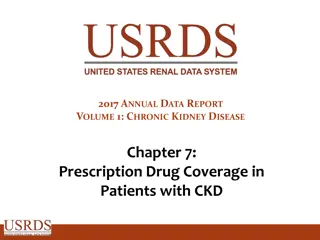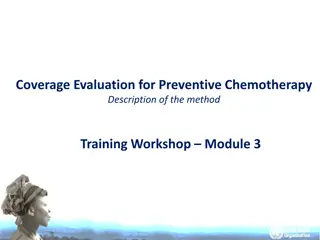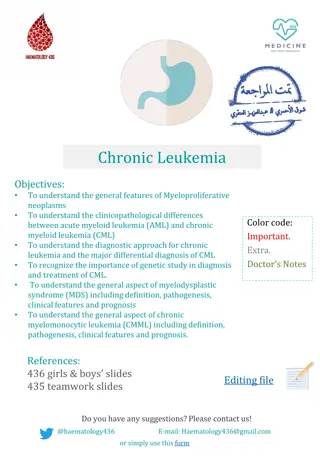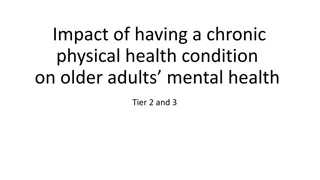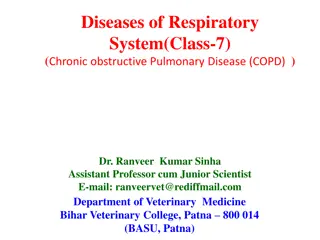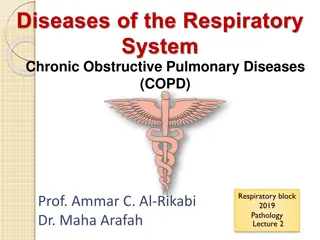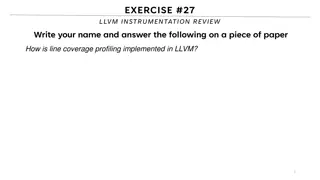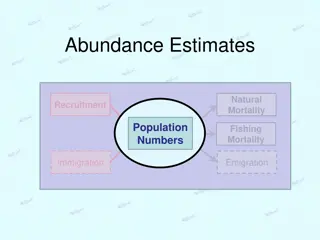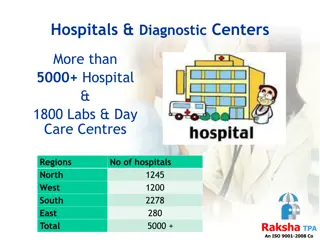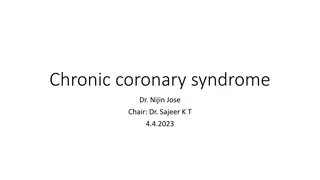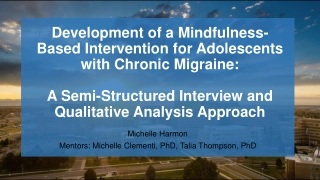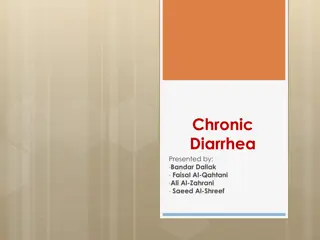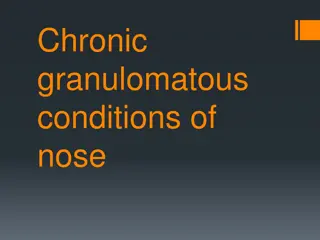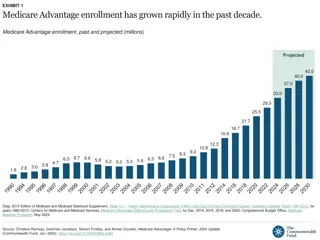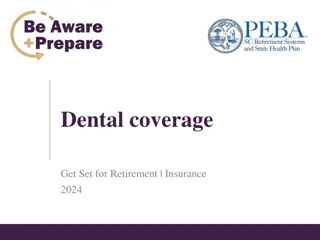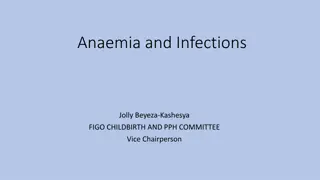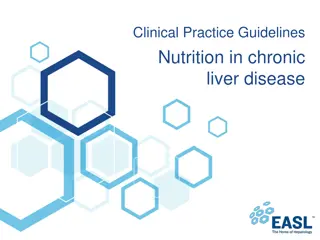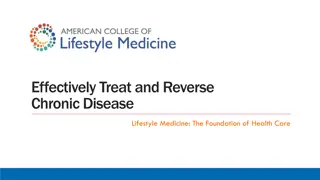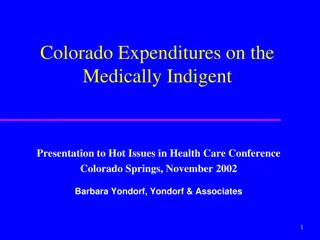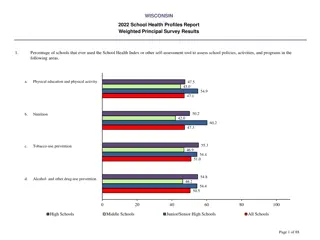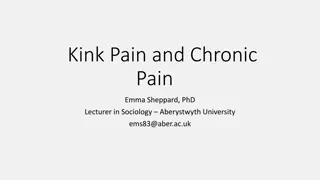Insights on Estimating Chronic Condition Coverage and Health Needs
This presentation delves into the crucial aspect of estimating need and coverage for chronic conditions through household surveys, focusing on measuring the need for treatment and population needs for health care. It discusses the challenges in accurately assessing population health needs, emphasizing the importance of survey questions and comparing algorithms with medical records. Furthermore, it highlights the WHO Study on Adult Health and Ageing (SAGE) which collects data on chronic conditions and multiple health indicators from respondents aged 50 and above across various countries. The study includes questionnaire modules, biological and clinical data collection, and performance tests to comprehensively assess health and functioning in older adults.
Download Presentation

Please find below an Image/Link to download the presentation.
The content on the website is provided AS IS for your information and personal use only. It may not be sold, licensed, or shared on other websites without obtaining consent from the author. Download presentation by click this link. If you encounter any issues during the download, it is possible that the publisher has removed the file from their server.
E N D
Presentation Transcript
Estimating need and coverage for chronic conditions through household surveys Ties Boerma, WHO, Geneva
Measuring the need for and coverage of treatment through surveys Acute conditions in children Diarrhea in the last 2 weeks Cough and breathing difficulties in the last 2 weeks Fever in the last 2 weeks Treatment Child taken to health facilities Recall specific treatments PLoS Medicine Collection 2012 Measurement poorer than thought, especially for suspected pneumonia
Measuring population needs for health care Prevalence of chronic conditions Not all people with condition X are using health services population survey is necessary Survey questions: self-reported medical diagnosis of a condition in a survey is not enough In high income countries service utilization is high and self reports are often taken as proxy for population prevalence If many are not using the services it is not sufficient Algorithms based on symptoms can provide an approximation of population unmet need for several conditions, but not all How good: compare with medical records (gold standard) Survey internal and external consistency this presentation
WHO Study on Adult Health and Ageing (SAGE) National samples: China, India, Mexico, Russia, Ghana, South Africa; Wave 1 completed 2010, Wave 2 going to the field; sample size 2,200-12,500 Collects data from respondents 50 years and older Questionnaire modules (similar to World Health Survey 2002-03): Chronic conditions: angina, arthritis, asthma & chronic obstructive lung disease, depression; diabetes, stroke Multiple measures of health and functioning: self-rated health, activity limitations; health score based on 8 domains; ADL, IADL; WHODAS Biological and clinical data collection Performance tests: handgrip strength, rapid/normal walk, cognition Anthropometry, blood pressure measurement, vision Blood sample taken on filter papers: HbA1c, lipids, and others
Questions on chronic conditions in SAGE Self-reported medical diagnosis Yes No A: No B: Treatment in last year C: Algorithm positive D: Algorithm negative treatment in last year A1: Algorithm negative A2: Algorithm positive
Questions in SAGE: population prevalence Self-reported medical diagnosis Yes No No treatment in last year A: Treatment in last year C: Algorithm positive Algorithm negative Prevalence = (A + B + C) / TOTAL Algorithm negative B: Algorithm positive Undiagnosed = C / (A + B + C ) Coverage = B / (A + B + C)
Algorithms Condition Main question Additional Angina pectoris Chest pain or discomfort (2) Rose questions (+3): disappears upon rest, location pain Arthritis Joint pains (1) Stiffness in morning, disappears upon exercise (+3 questions) Asthma Wheezing Tightness in chest, shortness of breath without exercise (+4) COPD Shortness of breath, coughing/wheezing, coughing sputum / phlegm Depression Sad/depressed; lost interest in "life"; energy loss 15 additional questions Diabetes None Cataract Cloudy blurry vision; vision problems with light (glare)
Methods to assess plausibility of self-reports 1. Internal consistency Data quality checks Consistency with other indicators (e.g. arthritis with mobility score or pain score or clinical tests) Comparison full algorithm with partial 2. Patterns by age, sex, and socioeconomic position E.g. more common among older people, women, poor 3. Patterns among countries according to risk factors, health systems, level of development; trends over time using WHS 2002-03
Angina: domain health score by diagnostic category Considerable loss of health for both SR & algorithm Health score by diagnostic category, angina 70.0 65.0 60.0 55.0 50.0 45.0 40.0 China Ghana India Mexico Russia S Africa No diagnosis SR Algo
Angina prevalence Patterns by background characteristics (excess fractions) 200 150 100 50 0 -50 Women / men 70-79 / 50-59 Poor40 / Best60 Urb / Rur -100 S Africa China Ghana India Mexico Russia
Angina treatment coverage Patterns by background characteristics (excess fractions) 200 Women / men 70-79 / 50-59 Poor40 / Best60 Urb / Rur 150 100 50 0 -50 -100 S Africa China Ghana India Mexico Russia
Angina pectoris - prevalence 3 Country patterns SAGE 40.0 35.0 30.0 25.0 20.0 15.0 10.0 5.0 0.0 China Ghana India Mexico Russia S Africa Self-reported medical diagnosis Algorithm
Angina pectoris 3 Country patterns and over time 50.0 45.0 Self-reported Algorithm positive 40.0 35.0 30.0 25.0 20.0 15.0 10.0 5.0 0.0 WHS SAGE WHS SAGE WHS SAGE WHS SAGE WHS SAGE WHS SAGE China Ghana India Mexico Russia S Africa
Angina pectoris coverage intervention 3 Country patterns and over time 90 80 WHS SAGE 70 60 50 40 30 20 10 0 China Ghana India Mexico Russia S Africa
Arthritis 1 Internal consistency Self-reports: 13-27% (median 19%) of those who reported a medical diagnosis did not have any treatment in the last year and did not meet the algorithm Algorithm questions: Chronic joint pains common: 47-75% (median 55%) of those did not meet the full algorithm; Those with full algorithm did not have more functioning loss than those with joints pains only Conclusion: could use either, affects prevalence
Arthritis: mobility score by diagnostic category Considerable loss of health for both SR & algorithm Mobility score by diagnostic category, arthritis 85.0 80.0 75.0 70.0 65.0 60.0 55.0 50.0 45.0 40.0 China Ghana India Mexico Russia S Africa No diagnosis SR Algo
Arthritis prevalence 2 Patterns by background characteristics (excess fractions) 120 100 80 60 40 20 0 -20 -40 -60 Women / men 70-79/50-59 Poor40/top60 Urban/rural -80 S Africa China Ghana India Mexico Russia
Arthritis treatment coverage 2 Patterns by background characteristics (excess fractions) 60 Women / men 70-79 / 50-59 Poor40 / Best60 Urb / Rur 40 20 0 -20 -40 -60 -80 S Africa China Ghana India Russia
Arthritis - prevalence 3 Country patterns and over time 35.0 30.0 25.0 20.0 15.0 10.0 5.0 0.0 China Ghana India Mexico Russia S Africa Self-reported medical diagnosis Algorithm
Arthritis 3 Country patterns and over time 60.0 50.0 40.0 30.0 20.0 10.0 0.0 WHS SAGE WHS SAGE WHS SAGE WHS SAGE WHS SAGE WHS SAGE China Ghana India Mexico Russia S Africa Self-reported Algorithm positive
Arthritis coverage intervention 3 Country patterns and over time 100 90 80 70 60 WHS 50 SAGE 40 30 20 10 0 China Ghana India Mexico Russia S Africa
Depression - prevalence 3 Country patterns and over time 20 18 16 14 12 Algorithm 10 Self report 8 6 4 2 0 China Ghana India Mexico Russia S Africa
Depression 3 Country patterns and over time 20 18 16 14 12 10 8 6 4 2 0 WHS SAGE WHS SAGE WHS SAGE WHS SAGE WHS SAGE WHS SAGE China Ghana India Self report Mexico Algorithm Russia S Africa
Depression coverage intervention 3 Country patterns and over time 60 50 40 WHS 30 SAGE 20 10 0 China Ghana India Mexico Russia S Africa
General service utilization Perceived needs and care received 100.0 90.0 80.0 70.0 China 60.0 India 50.0 Russia 40.0 South Africa 30.0 Ghana 20.0 10.0 0.0 Last 12 mo Received 12 Need is 50-70% of respondents in last 12 months Over 90% received care in last 12 months, except Ghana 82% It is likely that the care received figure includes self-treatment. It appears to be higher than admissions and OPD together.
Outpatient and Inpatient Utilization in the last 12 months Admission OPD 70.0 65 60.0 51 51 50.0 44 39 40.0 30.0 20.0 13.3 10.0 6.2 5.0 4.0 3.9 0.0 China India Russia South Africa Ghana Admission to hospital or long term care facility in the last 12 months: 4- 6%, except Russia Ambulant care utilization 40-50% in the last year, with India as outlier
OPD visits per year Visits per person per Mean OPD % OPD use visits 5.2 4.1 2.9 6.3 3.0 year 2.0 2.7 1.5 2.8 1.5 China India Russia South Africa Ghana Visits per year seems on the low side, e.g. China is about 3-4 visits for general population in the NHSS 2008, but the population 50+ years should have higher utilization Russia and China seem unlikely low 38.7 65.2 50.7 44.2 51.4
Excess fraction for self-perceived care needs in the last 12 months Excess fraction, self-perceived need for care 30 20 10 F/M 0 70-79/50-59 China India Russia South Africa Ghana -10 Poor/Rich -20 -30 -40 Expected patterns are women > men, 70-79 substantially higher than 50-59 years and poorest > best-off quintile Female excess as expected Age effect in the expected direction but smaller than expected Wealth effect in the opposite direction for 4/5 countries
Excess fraction for hospital admission in the last 12 months Excess fraction, hospital admission rates 60 40 20 0 F/M China India Russia South Africa Ghana 70-79/50-59 -20 Poor/Rich -40 -60 -80 -100 Same expectations for sex-age as for self perceived need, except more admissions for q5 Female male patterns variable Older respondents more commonly admitted or in long term care facility in 4/5 countries, in three the difference is large as expected; South Africa and Ghana results puzzling People in wealthiest households have higher admission rates in all countries, large difference in Ghana, China, South Africa, Russia (large confidence intervals)
Conclusions Algorithm seems useful way to capture those who have no self reported medical diagnosis The extent to which true population prevalence coverage rates are determined remains a big question Large and sometimes implausible differences between countries seems more suitable for in-country assessment than comparable global measures But consistency over time a concern (survey quality?) General service utilization questions: Cannot tell us much about unmet need/coverage of services Hospital admissions may be most reliable piece of information Much more work needed: on algorithms and on biomarkers


